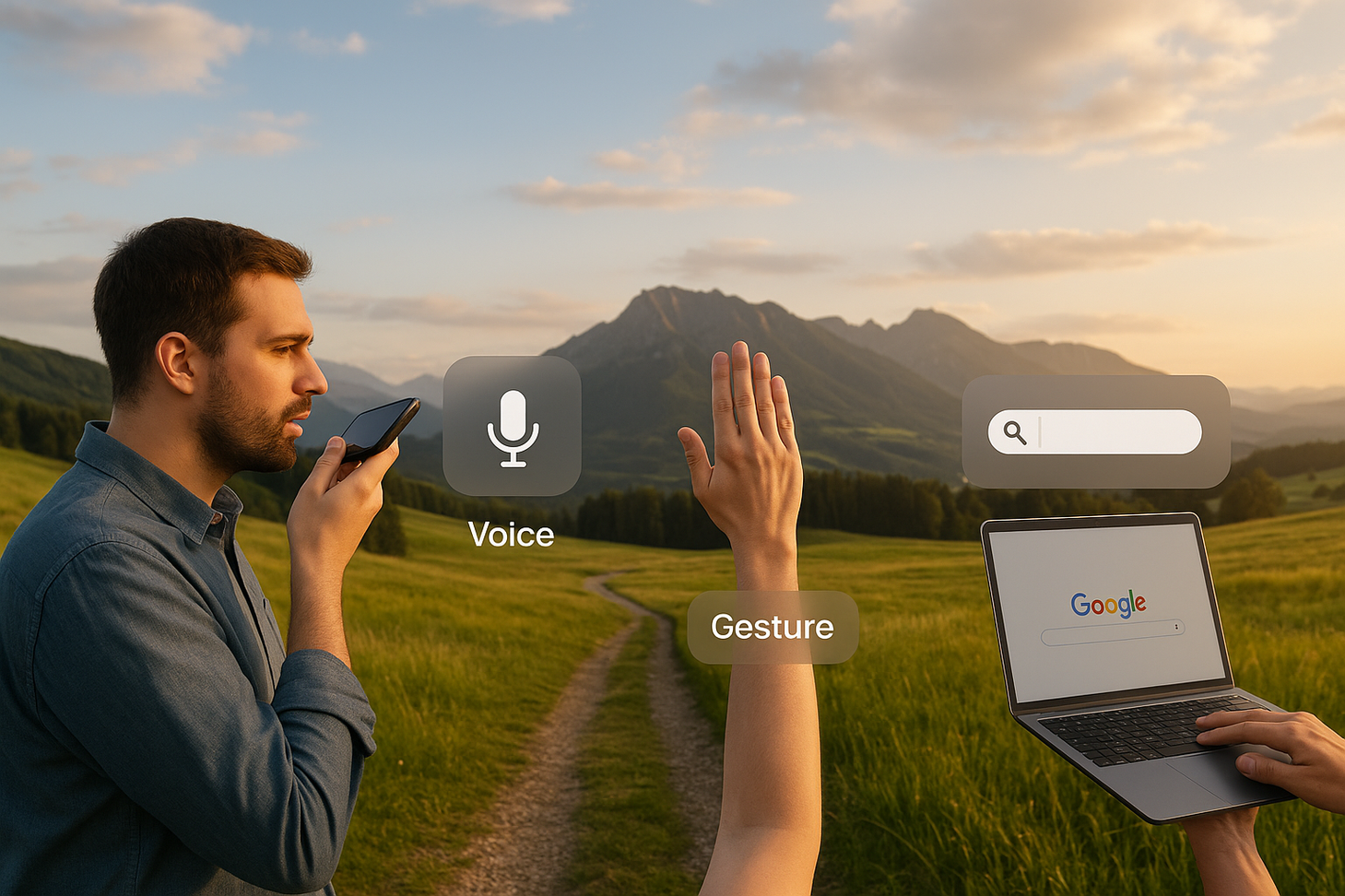In a world where our fingers scroll faster than our eyes can read, catching and keeping user attention is the name of the game. While visuals and sound have long dominated smartphone ads, a third sensory frontier is quickly emerging: touch. Specifically, haptic feedback, the small vibrations and physical cues your device sends back to you, has entered the advertising scene as a powerful tool for boosting brand engagement.
But how do subtle taps and pulses lead to higher click-through rates or better brand recall?
Let’s dig into how haptic feedback works in mobile advertising, why it resonates with users, and how you can utilise it to make your ads more immersive and effective.
What is Haptic Feedback, Really?
You’ve felt it a hundred times without even realising it. That subtle vibration when you tap a key on your phone. The gentle buzz as you unlock your screen. The soft pulse when you double-tap to like a post. That is haptic feedback.
At its core, haptic feedback refers to any tactile response you get from a device through the sense of touch. It is how technology talks back, not in words or pictures, but in physical sensations. In the world of smartphones, this can show up as a quick vibration when you tap a button, a gentle rumble during gameplay, or even a subtle tap that confirms your mobile payment has gone through.
But in mobile advertising, haptic feedback takes on a whole new role. It becomes a tool not just for interaction, but for engagement. We are not talking about those aggressive game controller-style rumbles. Think more along the lines of a featherlight nudge on your palm or the barely-there “click” you feel when interacting with dynamic advertisements.
These sensations are designed to be subtle yet purposeful. They’re not meant to distract, but to enhance the experience, making it feel more realistic, more interactive, and above all, more memorable. In an era where people scroll past content in seconds, that tactile cue could be the difference between forgetting your brand or remembering it.
Why Haptics Matter in Mobile Advertising
Let’s be honest: smartphone ads live in a chaotic ecosystem. Users are bombarded with content videos, pop-ups, animations, and sounds, all competing for limited attention spans. Flashy graphics and catchy tunes used to be enough. They’re just part of the noise.
And that’s exactly why touch is a game-changer.
By incorporating haptic feedback into smartphone ads, we unlock a third sensory channel: the sense of touch. Suddenly, we are not just seeing or hearing an ad, we are feeling it. That multi-sensory connection creates a more immersive experience that feels personal and instinctive. It is like your phone isn’t just showing you something; it is physically engaging with you.
And this isn’t just a feel-good theory. There’s solid science behind it.
Real engagement stats: A study by NeuroInsight revealed that mobile ads with haptic feedback led to a 50% increase in user engagement and a 38% improvement in brand recall compared to traditional ads.
These vibration-enhanced ads consistently outperformed their standard counterparts in three key areas:
- Attention captured
- Time spent engaging with the ad
- Emotional response to the brand
In short, adding haptic elements doesn’t just improve the user experience, it supercharges it.
From Passive Viewing to Active Feeling
We scroll. We tap. We swipe. But what if those micro-movements were met with micro-reactions? That’s the potential of haptics. Instead of passive viewing, users are prompted to interact in a way that feels natural and even enjoyable. And in a mobile ad setting, that tactile participation can lead to stronger brand engagement.
It is more than just “cool tech.” It is neuromarketing in motion literally.
Haptics work on a subconscious level, creating muscle memory and emotional association. That small buzz may seem insignificant in the moment, but paired with the right visual and message, it embeds your brand deeper into the user’s memory. That’s a marketer’s dream.
The Takeaway
In a world where attention is fleeting and screens are oversaturated, haptic feedback offers a new frontier for mobile advertising. By appealing to the human sense of touch, we create moments that are felt, not just seen. So the next time you’re building out your smartphone ad strategy, ask yourself this: “Can they feel your message?” Because when users can literally feel your brand, they’re far more likely to remember it.
The Psychology of Touch: Why Haptic Feedback Succeeds in Smartphone Commercials
Touch is the very first sense to develop in humans, and it is still one of the most potent. It is how we discover the world, form emotional bonds, and interpret the world around us. In the age of the internet, although we are frequently divided by screens, haptic feedback is bridging the gap between virtual and actual reality. Particularly in the realm of mobile phone advertising, touch sense is proving to be a brand engagement game changer.
1. Tactile Memory Enhances Recall
Have you ever wondered why you recall the sensation of your favourite hoodie or the click of a well-designed button? That’s because tactile memory provides an added layer to the way we encode and reclaim information. When users have a smartphone ad that, in addition to being visually appealing, is also perceived as different, through well-timed vibrations or pressure-sensitive taps, it leaves a sensory mark. This increases your message’s memorability. Research indicates that when touch comes into play, individuals tend to remember the brand name more, retain messages, and even follow through on purchase intent.
2. Touch Stimulates Emotion and Bonding
Think about the emotional comfort of a warm hug, a reassuring hand on your shoulder, or even that familiar buzz in your pocket that says, “You’ve got a message.” Touch is deeply tied to our emotions. When used effectively in mobile ads, haptic cues can trigger similar responses without needing physical contact. A soothing buzz while a user is interacting with an ad can develop subtle emotional signals that simulate real-world interactions. It injects a feeling of presence and association, and your brand message will feel more intimate, interactive, and human..
3. It Offers Instant Feedback and Establishes Trust
In normal digital interaction, typing, scrolling, or capturing a picture, haptic feedback is an unobtrusive workhorse. It verifies that your action has been detected. A vibration states, “Yes, this button was pressed,” or “This form was submitted.” In mobile advertising, this haptic verification does the same thing. Whether it is enlarging a product photo or interacting with an interactive narrative, haptics confirm that users’ input was received. This small but significant feedback loop results in more effortless, natural user experiences, less friction, and more trust in your brand’s online presence.
In a world where digital touchpoints abound but human touch is hard to find, adding haptic feedback to smartphone ads is not just novelty psychology. By tapping the primordial sense of touch, you can build stronger emotional connections, enhance message retention, and craft an experience that resonates literally.
Real-World Use Cases: How Brands Are Bringing Haptics to Life
Adidas
Adidas stepped up its mobile ad game by adding a tactile twist. In a campaign for their running shoes, they used gentle vibrations to draw attention to key product features, like the bounce in the midsole or the grip of the outsole, as users scrolled. The result? People spent more time with the ad, and brand recall shot up.
Pepsi Max
Pepsi Max turned a mobile ad into a fun, game-like experience. Users could “pop” virtual bubbles on the screen, each one delivering a small but satisfying vibration. That simple sensory reward made the ad more enjoyable and boosted both completion rates and product interest.
T-Mobile
To promote its 5G network, T-Mobile added subtle haptic pulses to its mobile ad animations. Every interaction gave users a quick vibration, a clever way to simulate speed and reinforce their message: fast, reliable, and powerful connectivity. The result? Higher engagement and a stronger brand connection.
How to Use Haptics in Ads Without Going Overboard
Using haptics in mobile ads is kind of like seasoning food—just the right amount can make it great, but too much ruins the whole experience. Here’s how to strike the perfect balance:
1. Keep It Subtle
You don’t need to shake the phone to make an impact. A gentle tap here or a soft buzz there can go a long way. Think about a quick vibration when someone swipes, or a light pulse when they unlock a reward. It is all about enhancing the moment, not overwhelming it.
2. Make It Feel Natural
The tactile feedback should match the action. If someone taps a button, give them a short, snappy “click” feel. Swiping through a product carousel? Add a soft buzz at the end to signal they’ve reached the last item. It should feel intuitive, not forced.
3. Pair It With Sight and Sound
Haptics work best as part of the full sensory package. When visuals, audio, and touch line up, the experience feels more real. For instance, if a character jumps in your ad, a small vibration timed with a sound effect can make that action pop.
4. Think About the Device
Not all phones vibrate the same way. iPhones and Android devices use different tech, so the same effect might feel totally different. Make sure to test your ad across multiple devices to keep the experience smooth and consistent.
5. Don’t Use It Just to Use It
Not every ad needs haptics. If the feature doesn’t naturally fit the story or interaction, it is okay to skip it. Haptics should elevate the experience, not distract from your message.
Common Haptic Ad Formats
Haptics aren’t just some fancy tech flex; they actually boost how engaging certain ads feel. Here’s where they really shine:
Playable Ads
You know those fun little ads that let you play a quick game? Haptics are made for them. Imagine flicking a soccer ball and feeling a tiny “thump” as if you really kicked it. It is a small detail, but it makes the whole thing feel way more real and fun.
Product Demos
Trying to show off how a product works or feels? Haptics can step in and do the heavy lifting. For example, a coffee brand could add a soft buzz when you “grind” the beans or “pop” open the lid in the ad. It is not just what you see anymore—it is what you feel, too.
Interactive Stories
Totally underrated: using haptics in story-based ads. As someone taps through a story, little pulses can signal key moments—like a nudge saying, “Hey, this part matters.” It adds rhythm and makes the story stick in your head longer.
Reward Moments
Let’s face it, we all love that feeling of unlocking something. A tiny buzz when you hit a milestone or grab a reward? Feels like your phone is giving you a high five. And honestly, who doesn’t want that?
Tools That Make Haptics a Breeze
You don’t need to be a coding wizard to start playing around with haptics in mobile ads. A bunch of platforms have made it super easy to experiment and add that extra “feel” to your campaigns:
Immersion’s TouchSense SDK
One of the pioneers in the haptics game, Immersion, provides you with the tools to incorporate subtle and responsive vibrations into your ads, whether you’re working on Android or ios.
Unity & Unreal Engine
Planning a playable or game-like ad? These engines support built-in haptic features that you can plug in without breaking a sweat.
Apple’s Core Haptics
For iOS apps or ads, Core Haptics lets you create detailed, layered vibration patterns that can match every tap, swipe, or moment of impact.
Google’s Vibration API
Working on Android or web-based ads? The Vibration API gives you fine control over how your ad “feels,” right down to the milliseconds.
Most of these tools come with ready-to-use effects and easy integration, think drag-and-drop, not a deep dive into code. So whether you’re just curious or ready to commit fully, getting hands-on with haptics has never been simpler.
Challenges to Watch Out For
Haptic tech brings some serious wow factor, but it is not without its bumps in the road:
- Device Differences: Not all phones play nice with haptics. Mid-range or budget models might dull the experience or miss it entirely.
- Battery Drain: Vibrations use power. On older phones, going overboard with haptics could lead to faster battery loss.
- User Settings: Some people just switch haptics off—so your ad should still work great even without the buzz.
- Overdoing It: If every swipe or tap vibrates, it can get irritating fast. Haptics should enhance, not overwhelm.
Metrics That Matter: How to Measure Haptic Ad Success
A haptic ad that feels great is only half the story. Here’s how to know if it is actually working:
- Engagement Rate: Users sticking around longer when haptics are part of the mix.
- Interaction Depth: Users exploring more, tapping, swiping, playing through interactive elements
- Brand Recall: Do people remember your product better after a haptic experience?
- CTR & Conversions: Are haptics nudging users to click or take action?
- Pro Tip: Run A/B tests, one version with haptics, one without. That’s the best way to see what’s really driving the difference.
What’s Next? The Future of Haptics in Advertising
As technology gets smarter, so will the way we feel our ads literally. Here’s a peek into where haptic feedback is heading:
Contextual Haptics
Imagine your phone giving you a gentle nudge that feels just right based on where you are or what you’re doing. That’s the power of ads that adapt their tactile feedback in real time.
Wearable Haptics
Smartwatches, rings, and even smart jackets are becoming tiny touch communicators. For advertisers, it is a whole new playground to create moments you can feel on your skin.
Emotion-Based Triggers
With AI and biometrics teaming up, haptics could soon respond to your mood. Feeling excited? Calm? Ads could pulse, buzz, or tap in sync with your emotions to make every message deeply personal.
Touch Is the New Click
We scroll past thousands of ads a day, but how many do we actually remember? Haptic feedback cuts through the noise. It turns passive swipes into physical interactions, making your message stand out and stick.
So next time you’re designing a mobile campaign, don’t just think about what people will see or hear.
Ask yourself what they will feel?






